At 5:30 yesterday morning Mia and I almost decided to stay home rather than make the hour-long drive to Antelope Island because the area up north looked to be socked in with clouds (the “Farmington Curse” I’ve mentioned before) but after we picked up our traditional “shooting breakfast” (chocolate donuts) we chose to take our chances and go anyway – a choice I’m glad we made.
As I drove the causeway toward the island it was cloudy as promised (poor light for photography) but almost immediately we came across this coyote skulking around the shore as it apparently looked for breakfast. Except for its face the coyote still had most of its winter coat and was pretty rough-looking.
There are thousands of American Avocets and other shorebirds along both sides of the causeway this time of year and at first I was surprised by how close the avocets were to the coyote. They were nervous and calling excitedly and some of them even crossed the sea-foam at the shoreline to get within a few feet of the predator.
It soon became apparent why the avocets were so stressed – this coyote was hunting eggs and had just found a nest of four of them. Here it is grasping one of them in its mouth.
Usually when I’ve seen coyotes eating it’s far from a delicate operation that involves gulping bites and ravenous behavior but not so this time. It slowly and very carefully opened the egg before consuming its contents. This egg (behind the left foot) almost looks like it has been pipped by the chick as it hatched but I’m convinced that’s not the case. Here the coyote is sniffing the other three eggs in the nest.
Now here’s where things start to get a little strange. I’d have bet my lens cap that the coyote would eat all four of the eggs but it didn’t. After consuming the contents of the first egg it licked its chops…
and then continued along the causeway with its nose to the ground and ignoring the excited avocets as it looked for more nests.
And it didn’t take it long to find one. Here the coyote is grasping another egg in its mouth which I assumed it would eat. But I was in for another surprise.
The coyote picked the egg up and slowly wandered west with it. It carried the egg quite a distance, at one point even carrying it on the paved road.
But then it then it went back down closer to shore – still carrying the egg and seeming to look for “something”.
It turns out that what it was looking for was a bare patch of ground with fewer rocks so it could bury the still intact egg. Here it’s digging a small hole with the egg still in its mouth.
It placed the egg in the hole and then covered it up with its snout. And then the coyote simply wandered away, apparently to do more hunting. At this point we let the coyote be and continued toward the island.
Animal behavior is often difficult to account for but here’s my theory. This coyote was already sated on eggs and was caching food for future use. I’m unsure as to why it left the other three eggs in the first nest and continued to hunt – perhaps the hunting instinct is just so strong as to be difficult to ignore.
Whatever the explanation it was a fascinating episode to watch and photograph.
Ron


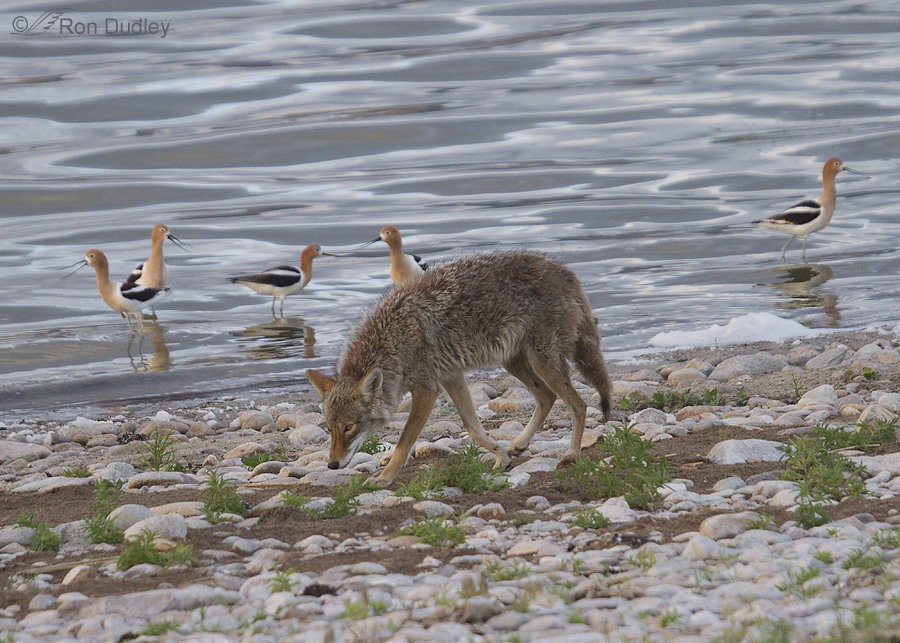
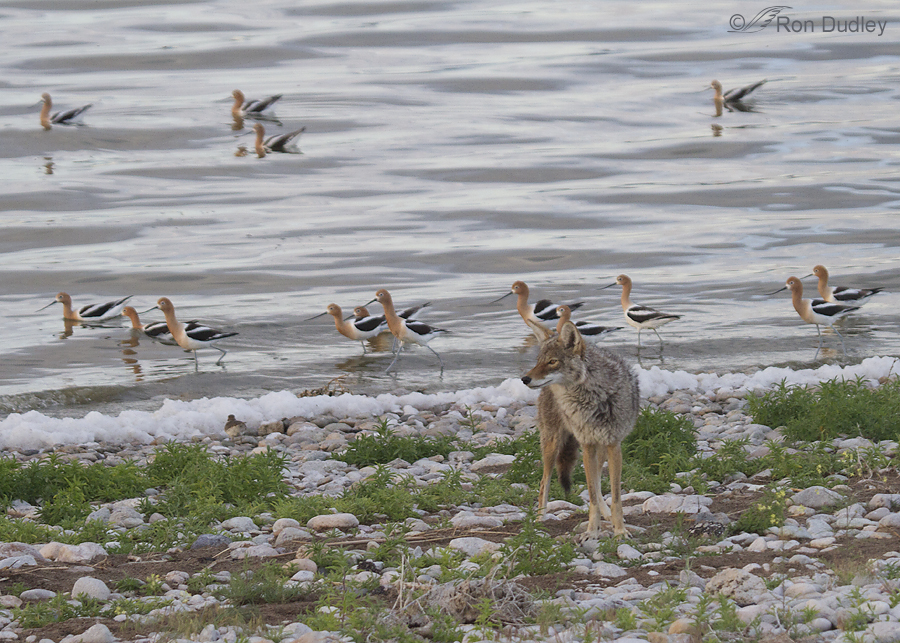
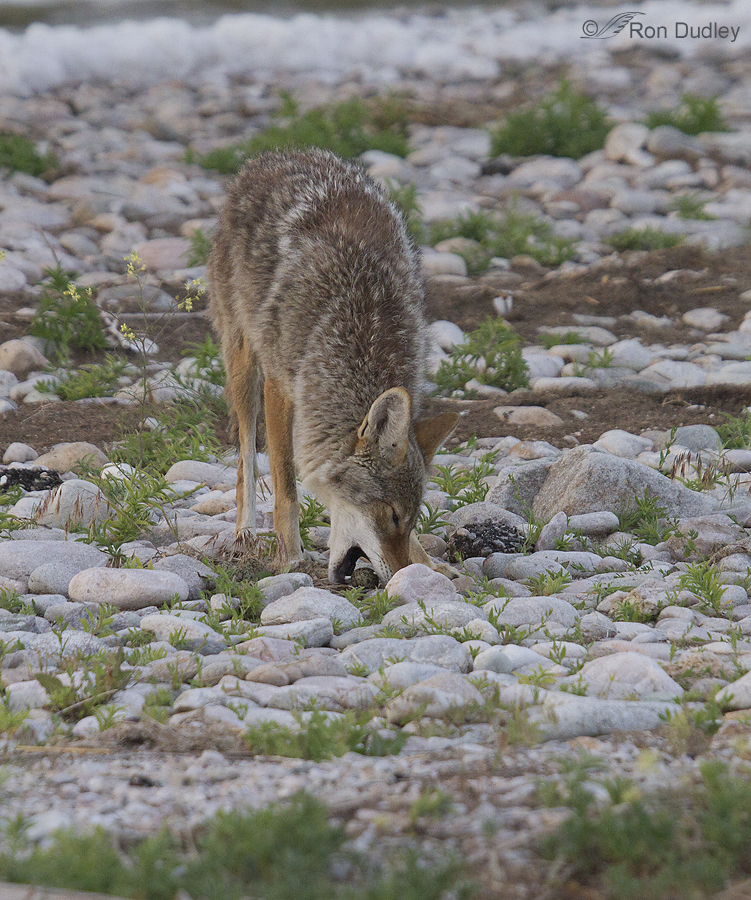
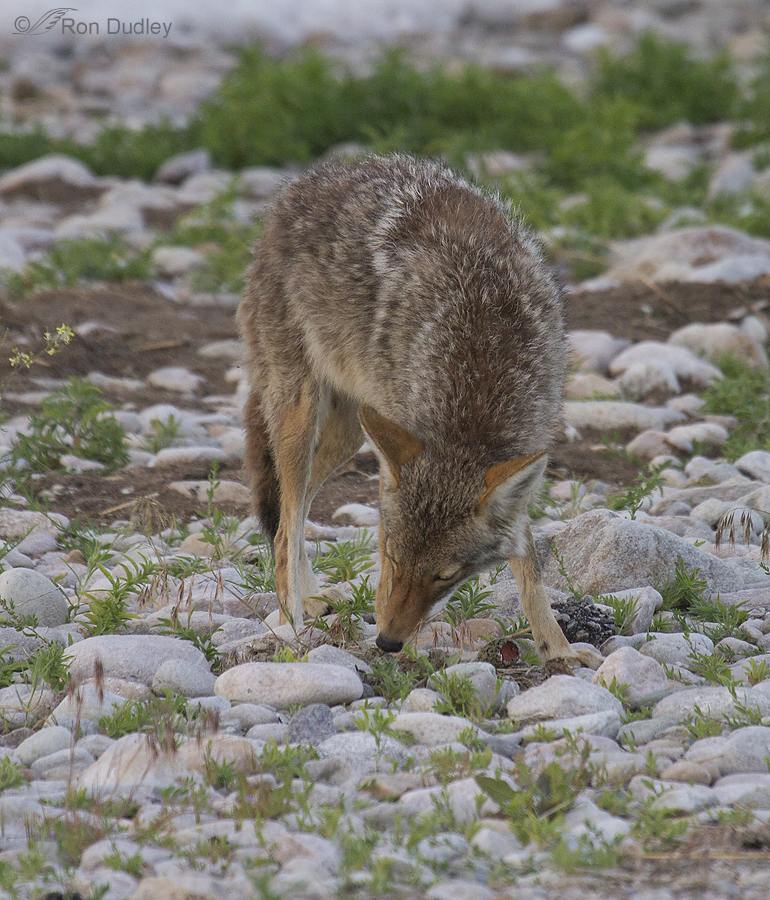
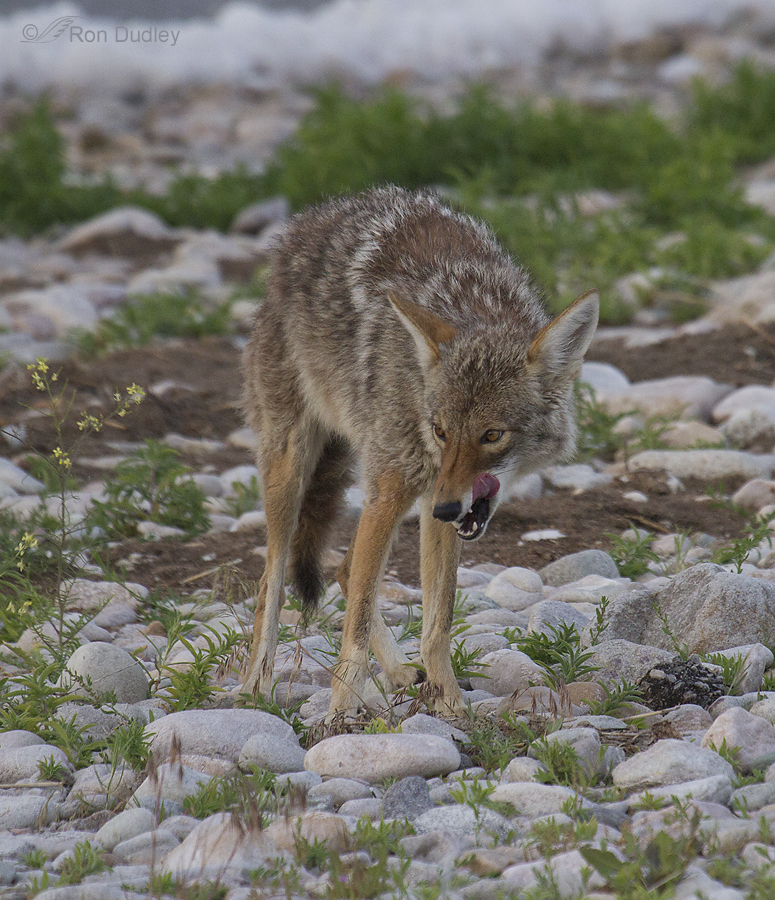
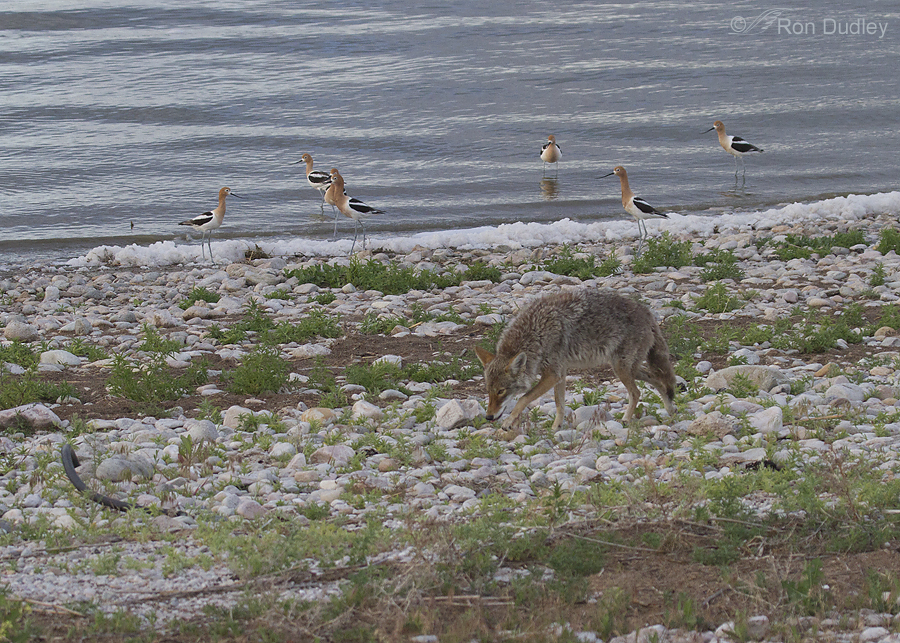
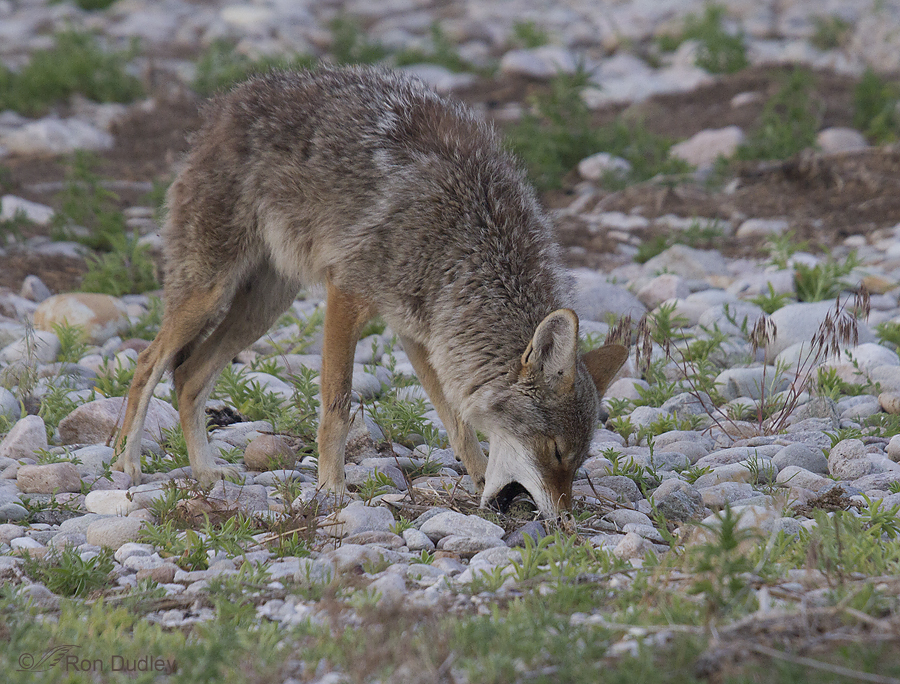

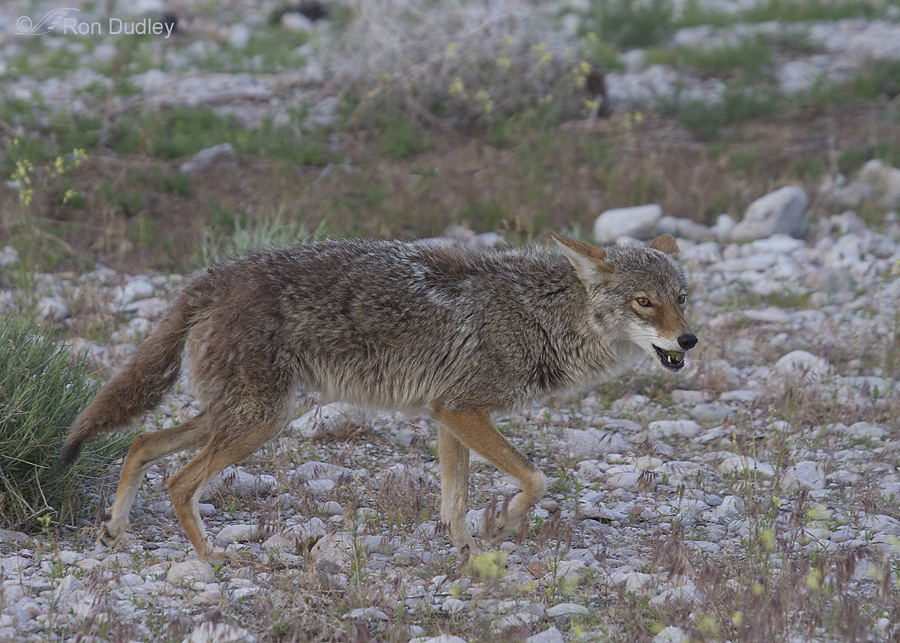
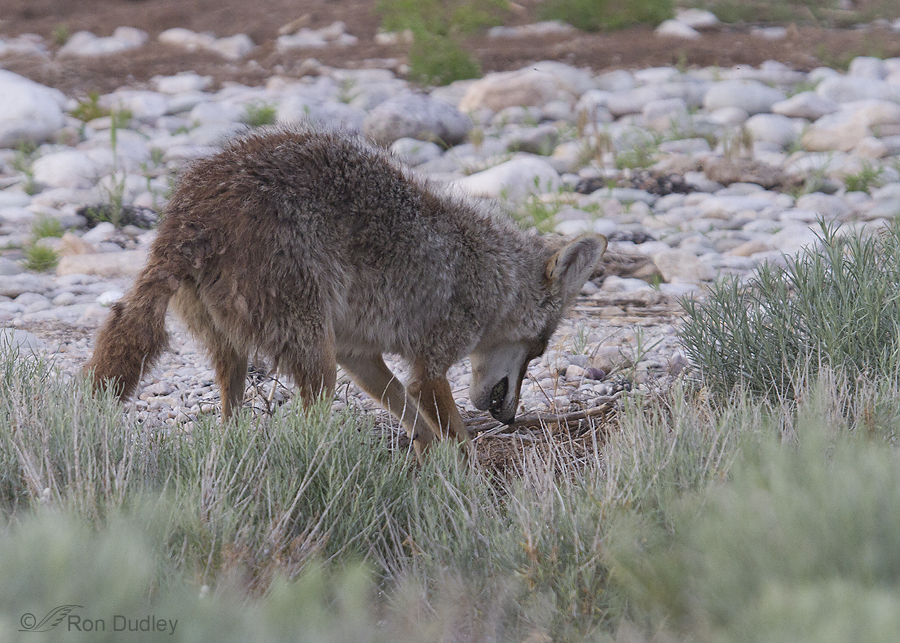
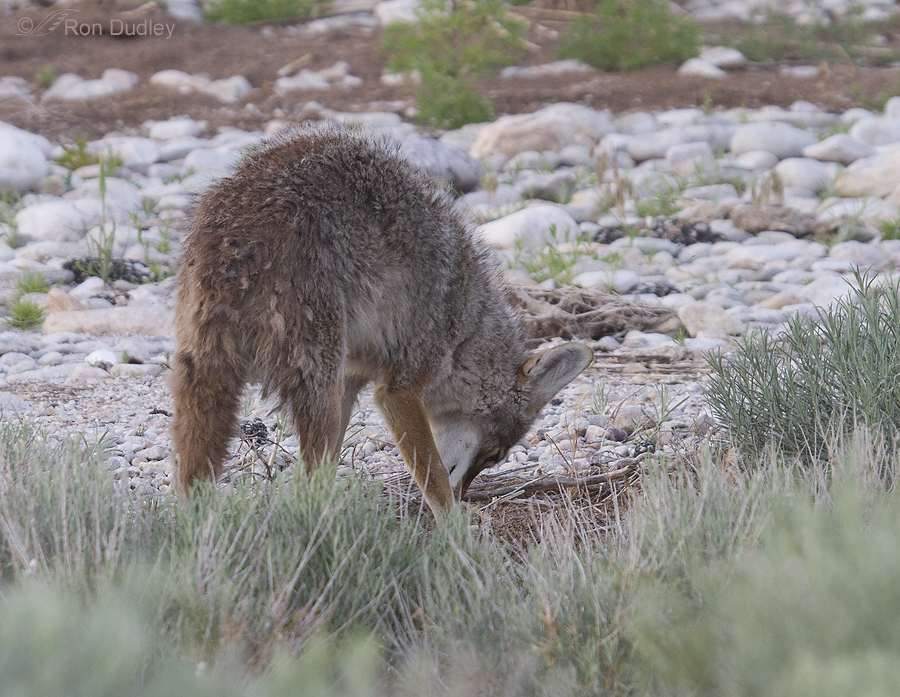
Perhaps the Coyote new he’d find those three eggs there the following morning when he would be hungry again. When I shop at the grocers, I don’t buy every gallon of milk they have…
This is a good example of why this is one of the few nature photography blogs I follow. By doing so, I see exceptional photos, taken by a biologist with a reporter’s eye for a good story. Hopefully, the call of the chocolate donuts will keep you and Mia on the prowl.
Dave Sparks took the words right out of my mouth! This is my absolute favorite nature site by far! I only lament the fact that I can no longer read the text on my iPad without a lot of magnification and scrolling. Still, that won’t stop me from enjoying this site. Thank you again Ron!
Ron, it’s such a delight to see the series that you and Mia capture together, and yet with different points of view. I was just over at her blog and saw this coyote story! Simply amazing. Were there a lot of avocet nests in the area? That is, does it appear that there will be young to raise, despite this type of predation? I’ve been photographing Caspian Terns here. Poor things are subject to terrestrial and aerial predation as I know a lot of ground-nesting birds are. They’ve been bouncing around rooftop sites, now, looking for a roof free of predation, but so far, no luck.
An excellent series of photos…what great luck to see this. More and more I think I must drive down and see your Antelope Island. You’re a great photographer.
I am probably nearly as pleased that you and Mia didn’t stay home as you were. What an amazing thing to see. I love that the coyote was able to carry the egg without damaging it too. Future food? When first you mentioned that it was moving the egg I wondered whether it was foraging for its young (or mate). Animal behaviour is ALWAYS fascinating, and often a mystery too.
…great sequence…great story…beautiful animal!
What a wonderful catch. Glad you shared. Am sure this is something I would never get to witness.
What a story in pictures! You made my day! Thanks for this insight into the complicated lives of those who share this environment with us.
Where I live (San Joaquin Valley, Ca) we have a large population of coyotes. They seem to have a traffic system that is easily seen in our area (pastures). Around 9am every morning you can see them hiking arcross the fields heading towards the vineyards possibly looking for small game. I wonder (cuz because Ron makes me do that a lot) if the egg will serve as a marker, to remind himself where he was successful. Being a male, he might be leaving a teaching moment for his pups? After all its hardly a meal for a large coyote. In our area, you can see families trecking together in a loose group, maybe up to four, somtimes five.
As a side note. I have large black German Shepards that have always acted as a reason for the coyotes not to put my house on thier daily route. That’s where my home name came from…Black Coyote Ranch….:)
Tim
That coyote looks to be in decent shape…so many look moth-eaten and scruffy. May be a male. A female with babies to feed might not have buried the egg and would probably look rattier. Our eastern coyotes tend to be bigger-taller and huskier-than the western ones, and supposedly have more wolf DNA. Some of them look quite a bit like wolves.
I think it’s a male too, Patty. Most of the adult females this time of year have obviously swollen teats.
Thanks for the wonder shots and once again giving us another glimpse into some interesting behaviors. I love the detail in the coyote, the rich colors of the avocets against the pewter water, and the patterns in the waves. I’m glad you decided to go….proves you never know…please send donuts!
I don’t give up my donuts easily, Patty…
Excellent photos and narrative Ron ! I knew foxes cached food, so interesting to see coyotes do this as well.Thanks !
I’d never seen them cache food before either, John.
These are amazing shots! How wonderful to beable to see this very interesting behavior. Most of us will never be able to witness this in person. Thanks for giving this wonderful glimpse.
Thanks Ron!
Charlotte
Thank you, Charlotte.
What a beautiful and informative sequence of photos of a fascinating animal! Thanks for sharing the images and an interesting narrative, Ron. After watching the coyote, did you wish you had had eggs for breakfast instead of chocolate donuts?
Nope, those eggs didn’t tempt me in the least, Dwynn! (though I do think I noticed Mia licking her chops…)
Excellent images of animal behavior we don’t see, because it is not readily recorded. Although some will be concerned, this is behavior that happens in nature and the animal world. Time and time again science has shown that a single species will multiply without any predation, that species would so over populate they would end up eating up their food supply and the result would be starvation. Predators have a role to play in the natural world!
Many thanks for the story and the images.
Dick, I completely agree. And beyond the beneficial effects predators serve for population control, there’s also the natural selection process going on that hones the behaviors and physical characteristics of both predator and prey. These selection pressures are good for both groups in the long run.